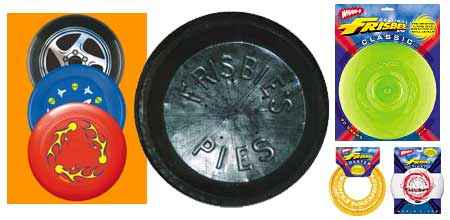Frisbee

Synopsis of Toy
“When a ball dreams, it dreams it's a Frisbee"
Everybody wants a piece of the Frisbee pie. There is debate and controversy surrounding its invention, there is debate and controversy about where it was first tossed around, and there is debate and controversy as to why some dogs just like playing ball, but some seem born to chomp down on a Frisbee. Okay, we made that last one up—just trying to add our own little crumb to the legendary Frisbee pie. Well, why not? Everyone else has.
Flying discs have been around a long, long time—very little debate there. The ancient Greeks threw discuses in their Olympic Games, and ancient Romans fought off Hannibal, in part, by throwing around their razor-sharp shields as if they were Frisbees. Only, um, a lot heavier and a lot deadlier. In more modern times, it wasn’t just athletes and soldiers who liked the feel of a disc-in-hand. For example, townspeople around Bridgeport, Connecticut have loved throwing around the pie tins and cookie tin lids from the Frisbie Pie Company ever since the pies were a’ coming out of the oven in 1871.
Whether the townspeople were the first to toss the tins, or if it was actually the truck drivers who worked for the Frisbie Pie Company and picked the tins up when things got slow…well, who’s to say? But those pie tins, or at least the tradition of the tin-throwing, eventually made their way to nearby colleges. Yale was one of them, and alumni today are known to claim that years ago, a student named Elihu Frisbie, was the first to toss the tins around and yell out “Frisbie!” whenever the metal was about to connect with some poor unsuspecting classmate’s person. Depression-era kids played catch with metal pie tins (and paint can lids and paper plates) all the time, and some believe that the idiosyncratic tin ‘catch’ game was spread throughout the nation by soldiers, who, like those pie company truck drivers, played in their down time. As you can see, there’s just no way to tell who pressed palm to pie tin first.
Two men named Walter Morrison and Warren Franscioni remembered this throwing of plates and tins, but they also remembered how breakable, loud, and potentially painful the tin was. Consequently, they conceived of casting a disc in plastic—a material that was very easy to get after the Second World War. So in Franscioni’s San Luis Obispo, California garage, these men crafted the first crude plastic saucer, replete with a fold-over lip for better aerodynamics. Playing on the Roswell saucer-sightings in 1947 and the UFO interest that was percolating throughout the country, they named their disc the “Flying Saucer.”
In 1948, the men formed a company called Partners in Plastic, or Pipco, and in conjunction with the Southern California Plastic Company, they manufactured a slew of Saucers. They then hit the road with showy how-to Saucer demonstrations, because back then, nobody knew the proper way to throw the things. And thanks to their efforts, their invention was soon sold at places like Woolworth’s and Disneyland, always for one dollar. Morrison and Franscioni even made a deal with cartoonist Al Capp, who included a Saucer in his Li’l Abner strip in the early 1950’s, and then, unfortunately, got sued by Capp when they started including Abner inserts in their Saucer packages without permission. Nobody ever said the Saucer boys were coy when it came to their sales techniques.
When that initial Saucer spurt slowed down, Franscioni re-joined the Air Force and Morrison went on to make his second disc, the “Pluto Platter” in 1951. This disc looked more like a UFO than the Saucer did—it even had a simulated cabin, complete with portholes. In 1955, Morrison was up to his old demonstration tricks again, this time in a Los Angeles parking lot. Rich Knerr and Spud Melin ambled over—and these guys had recently founded a toy company named Wham-O (they had one product at that point—the wooden slingshot, and ‘wham-o’ was the sound the slingshot’s pellets made when they hit something). Morrison sold the rights to Wham-O, and when Knerr was visiting East Coast colleges in the mid-1950’s to peddle his Platters, he caught sight of flying pie tins and kids yelling “Frisbie!” Knerr took the term, spelled it phonetically, and his company’s newest product officially now became the Frisbee.
Cleverly, Wham-O pitched Frisbee playing as not just a leisure activity, but also as a brand new sport. The toy’s sales were boosted by the mid-1960's invention of “Ultimate Frisbee,” a cross between American football, soccer and basketball (but with no balls, just discs), which is still played on college campuses today. Wham-O continued to flex its toy muscles with the Hula Hoop, the Super Ball, the Water Wiggle and many more, but the Frisbee would become, in those years, the company’s #1 profit generator.
Mattel bought Wham-O in 1994, but the company still makes Frisbees—of course, these days, dozens and dozens of other companies have flying discs of their own. There are plenty of variations of the original design: trick Frisbees and sport Frisbees and Frisbees for beginners. It’s estimated that more than two hundred million of the things have been bought and tossed around in the last fifty years. From pie tin to plastic, from a garage to the world, whether your catch-partner is canine or human, get ready to fling those wrists.
